The small, coastal Sultanate of Oman lies just south of the skyscrapers of Dubai, just east of the Empty Quarter of Saudi Arabia, and just across the Persian Gulf from the ancient civilizations of Iran and India. About the size of Kansas, Oman is home to towering mountain ranges, vast deserts, and around 2,000 miles of fertile coastline. The story of Oman, its people, and their cuisine is inexorably linked to the sea, not only for the bounty of food it provides, but, more importantly, for the trade routes it supplied between Oman and the rest of the ancient world.
Long before the discovery of oil, the people of Oman were seafarers, date farmers, and Bedouin. Theirs was a diet of survival, based on nonperishable items that could feed a crowd. In lean times, that could mean dates and camel’s milk; during good times, meals would include large platters of rice studded with exotic spices from all over Asia, eaten communally by hand in a tradition that continues to this day.
No matter what was on the table—be it just a few dates and light, tealike Omani kahwa (coffee)—there was always enough to feed an unexpected guest. Hospitality is fundamental to who the Oman people are.
The story of both Oman’s global connections and its distinctive customs is reflected in the cuisine, which is why the best way to get to know the Gem of the Indian Ocean is by tasting it.
If a trip to Oman is not on your calendar anytime soon, cook your way through the Sultanate with recipes like savory, turmeric-tinted chicken madrouba, citrusy seafood paplou soup, and Zanzibari coconut-creamed spinach from “The Food of Oman: Recipes and Stories from the Gateway to Arabia” (Andrews McMeel, 2015).
Omani kahwa and dates
Hospitality is ingrained in the culture of Oman, from the formal way even intimate friends exchange greetings to the ever-present dallahs (pots) of hot Omani coffee and small dishes of dates.
Dates are an essential part of Omani life and seen as a divine gift. The fruit is eaten fresh, just after harvest, and dried for the rest of the year. The fronds of the date palm are woven into mats, baskets, and roofs for homes. There are hundreds of date varieties in Oman, and many Omani families have their own date tree or grove, from which they supply themselves as well as friends and neighbors. Even in offices, platters of dates are often found on tables along with hot dallahs of kahwa.
Omani coffee is almost green, lightly roasted, and ground with cardamom. After the delicate elixir has been brewed, a teaspoon or two of rose water is added to the insulated serving pot. The kahwa is served in small, handless glasses called fenjans. The accompanying dates act as natural sweeteners. A guest’s fenjan will be refilled continuously until he or she shakes it, signalling that they have had enough. Small portions ensure that the coffee stays hot and that the host has ample opportunity to honor his guest and his home through his act of hospitality.
Where to eat it
Upon entering pretty much every nice hotel in Oman, you will be greeted with kahwa and dates. The same holds true for many businesses and every home, should you be lucky enough to get invited over for a meal. Omani kahwa and dates can also be ordered at Al Makan Cafe on Al Shatti Street (known locally as “Love Street”), where you can enjoy breathtaking views of the sea during the day or watch the young men show off their tricked-out 4x4s and sports cars along the corniche in the evenings. If you want to take some kahwa and dates home, go to LuLu, the large hypermarket chain, take a walk up the date aisle, and ask for samples at the luxury date counter.
Al Makan Cafe
Location: Al Shatti Street
Contact: +968 22 097777
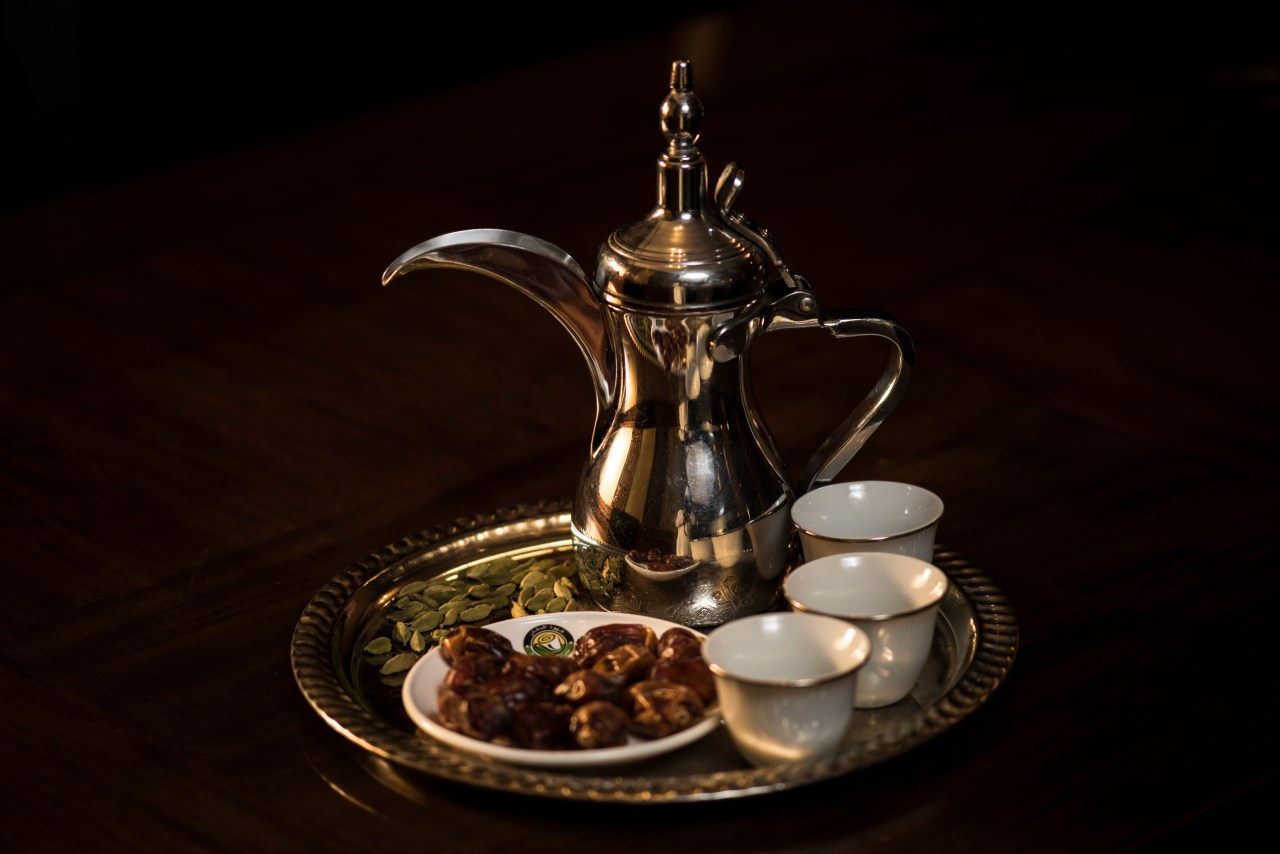
Black limes and maleh
Omanis were historically either seafaring or leading overland trade caravans, so many of the splendid items passing through their ports needed to be preserved for journeys to and from far-off places.
One such import was the Malaysian lime. In an attempt to preserve them, traders blanched the limes and then dried them on mats. Their outer skins hardened and darkened, while the flesh inside became black and gummy with tart, almost-fermented flavor. Known as “black limes,” “limoo Omani,” or even “Persian limes” (the country was a main importer), this ingredient is now an essential item in the pantries of Iraqis, Iranians, and Omanis.
The seafood caught off the shores of the Sultanate was also preserved. Shark and fish were salted and cured, then rehydrated with lime and onion for dishes called awa’al and malleh, which remain popular in Muscat to this day. In the meat-loving southern region Salalah, strips of beef or camel meat can be found salted and hanging in curtains on the roadside, waiting to be pulled down and fried in cubes of fat to make the shelf-stable local specialty called ma’ajeen.
Where to eat it
Ma’ajeen can be purchased from the roadside stalls along Eaton Street in Salalah. To taste modern Omani versions of malleh or awa’al, including a malleh salad, go to Bil Khams restaurant in the Al Ghubra neighborhood of Muscat.
Bil Khams
Location: Al Ghubra
Contact: +968 22 060072
Shuwa
Shuwa is considered by many to be the national dish of Oman. Typically only served for special occasions, like weddings or the Eid holidays, this time-intensive dish is prepared by slathering meat (beef, lamb, goat, or even camel) with a mixture of oil and dark spices, like hot chilies, cloves, coriander, cardamom, black pepper, and cumin. The meat is wrapped in banana leaves and stuffed into a bag made of woven palm branches, which is then placed into an underground pit over hot embers, where it smokes and cooks for at least 24 hours. The Eid holidays in Oman are a three-day affair. Typically the shuwa is prepared and placed into a pit on the first day, then taken out for a feast on the second or third day. Most people do not have their own shuwa pit, so the preparation becomes a communal event. People from around the town or village place their marked shuwa bags in a single pit and help one another pull them out. Served atop a massive platter of rice, shuwa is meant to be shared, both in the making and in the enjoyment.
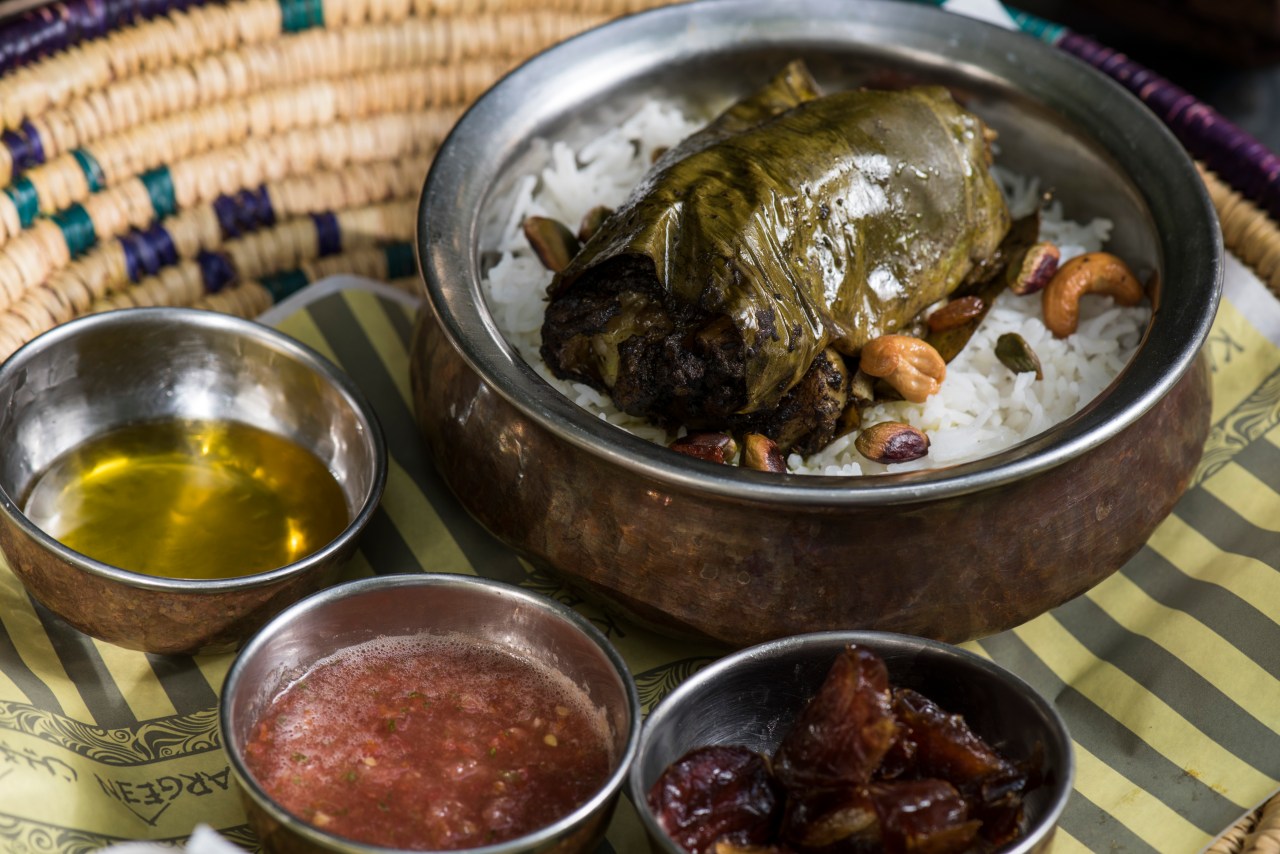
Where to eat it
For a nicely presented, single-serving version of shuwa, go to Kargeen Caffe in the Muscat neighborhood of Madinat Sultan Qaboos (MQ). For a more authentic, less photogenic version, go to the popular taxi-driver hangout Bin Ateeq, on the Al Khuwair service road.
Kargeen
Location: Al Bashair Street, Muscat neighborhood Madinat Sultan Qaboos (MQ)
Contact: +968 24 699055
Bin Ateeq
Location: Al Khuwair service road
Contact: +968 24 478225
Rice
Rice is a staple of the Omani midday meal, especially on Fridays when families gather to share lunch after the noontime prayers. It is traditionally served on a large, metal tray and crowned with a bit of meat. The family or group of friends will sit on the floor around the platter, using only their hands to scoop up bite-size morsels of rice and meat. There is a unique intimacy that comes from sharing a single plate of food, and it can be felt as mothers and fathers pull choice pieces of chicken off the bone and hand-feed them to their children. It can be felt too in the closeness of the bodies surrounding the platter, united in their enjoyment of this most comforting dish.
The variety of rice dishes abounds in Oman. The most common are variations of kabuli or machboos, rice dishes seasoned with fried onions and an Omani masala of cloves, cardamom, cinnamon, coriander, and other whole or ground spices, served with either boiled and fried chicken, meat, or fish. Another popular restaurant staple is the Yemeni dish, mandi, which is flavored with the drippings of the meat or chicken that adorns it. There is also an entire canon of Omanized biryanis, which are far less spicy than their South Asian counterparts, but no less rich.
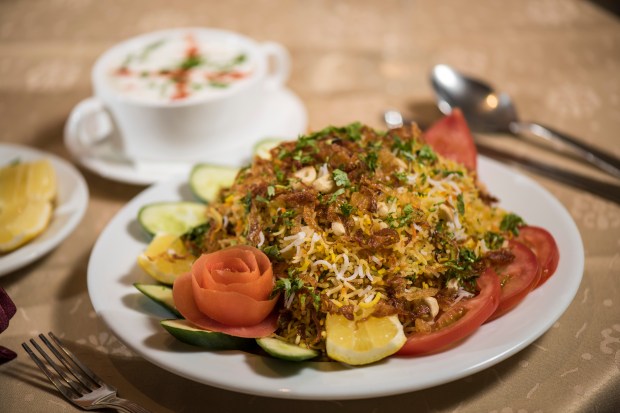
Perhaps most interesting are Oman’s mashed rice dishes. Essentially, they are savory porridges. The classic is arseeya, for which rice is boiled with boneless chicken until the mixture can be mashed to a smooth consistency. It is usually seasoned simply, with black pepper and a little cinnamon, and served with a sour sauce called torshe. It is a popular dish on the first day of the Eid holiday and is commonly referred to as Omani comfort food. At the other end of the porridge spectrum is the more intensely flavorful madrouba, for which rice is boiled with chicken in a well-seasoned broth and topped with cardamom-scented ghee and fried onions.
Where to eat it
The best example of Omani-style biryani can be found in the dining room of the Bowshar International Hotel. What it lacks in ambiance is made up for with the perfectly sweet-savory hamour fish (a local grouper), chicken, and prawn biryanis. To enjoy mandi on the floor of your own private “family” room, try Osan, in the Al Ghubra area of Muscat. Or stop at nearly any of the small restaurants near mosques or on the side of the road in small villages for a simple meal of Omani rice and chicken. Madrouba is difficult to find outside the home, so try making your own with this recipe.
Bowshar International Hotel
Location: Sultan Qaboos Street
Contact: +968 24 491105
East African coconut vegetables
The East African island of Zanzibar was part of the Sultanate until 1965. In fact, it was home to the capitol of the country for some time as well. The long-standing relationship between the island and the mainland have made many Zanzibari dishes an essential part of Omani cuisine. The island was perhaps most famous for its clove plantations, and that signature spice is present in almost every Omani dish and spice blend.
You will be hard-pressed to find many vegetable-focused dishes in Omani cuisine. The Zanzibari contributions are the major exception. Coconut-simmered spinach, coconut and hot chili beans, and mashed green bananas are a few of the staples in Zanzibari restaurants and Swahili homes throughout the country.

Where to eat it
In the Al Ghubra neighborhood of Muscat, Zanzibar Island Restaurant & Coffee Shop is an eclectically decorated space run by a Zanzibari Omani who left the island after the revolution in 1965. If he is sitting at the large front table when you arrive—and he often is—he will likely take your menus away and simply ask, “Arabic or African?” Go for the African sampler, a selection of home-cooked specialities, such as coconut-simmered vegetables and beans and either fried fish or chicken, along with fresh-cooked chapati. If the owner is not around, ask your waiter for the sample plate with both rice and bread. Your meal will be rounded out with complimentary clove-infused kahwa and dates.
Zanzibar Island Restaurant & Coffee Shop
Location: Al Ghubra
Contact: +968 97 10359
Fresh seafood
Along the coast of Oman, tuna, massive prawns, lobster, crab, hamour, sheri, sultan ibrahim, and even abalone in the far south are caught fresh daily. The best way to eat any of these catches is simply grilled, which is how they are served at a few small restaurants near the fish markets. In the small coastal village Al Ashkara and in the ancient port city Sur, cuttlefish (sort of like a giant squid) is the specialty. The influence of longtime trade with South India via Zanzibar is felt in the preparation of the local catch, which is on offer either grilled, fried, or in a thick, slightly spicy masala gravy along with paratha.
Where to eat it
In Muscat, visit Shrimps Coffee House, near the Seeb Fish Market, for fresh crabs. Visit Fishers Grilled, across the street from the Mutrah Fish Market, for well-seasoned grilled whole fish, sold by the kilo and served with hummus, pita, and salad. Head to Turkish House, a small restaurant in Al Khuwair owned and run by a retired fisherman, to taste unadorned grilled fish and the largest, sweetest prawn you’ve ever had.
Shrimps Coffee House
Location: near Seeb Fish Market
Contact: +968 95 033490
Fishers Grilled
Location: across from Mutrah Fish Market
Contact: +968 99 463561
Turkish House
Location: Al Khuwair
Contact: +968 24 488071
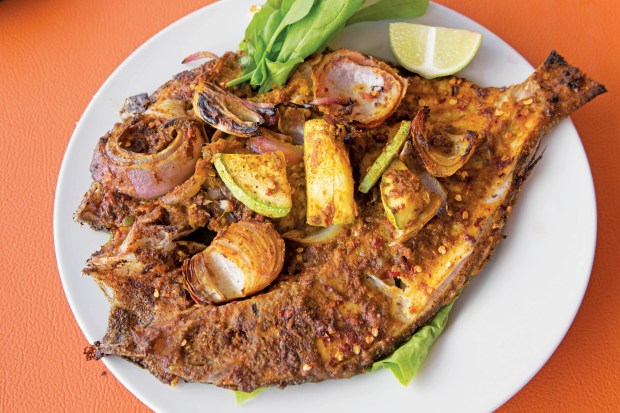
Omani bread and karak tea
A reflection of recent connections between the Persian Gulf and South Asia, this contemporary favorite combines traditional Omani flatbread with an Omanized version of the South Asian staple chai masala. A beloved breakfast, especially on road trips, it is served from small roadside shops. The tea is a thick, sweet mixture of black tea, condensed milk, sugar, and spices, ranging from za’atar (a mix including thyme) to mixed masala and saffron. The rich, fully appropriated Gulfie drink is paired with khubz ragag, a paper-thin Omani bread, which is smeared with all kinds of toppings depending on the shop. Most famously, it is covered with spreadable white cheese, quick-cooked egg, and crushed, chili-flavored Chips Oman potato chips. The simple and delicious meal is especially welcome in more remote areas, like the base of the Jebel Akhdar mountains, where hot food options are limited.
Where to eat it
Stop at any roadside karak shop and ask for Omani bread with cheese, egg, and Chips Oman, along with a karak chai. The best place in Muscat to enjoy this simple fare is Tea House, attached to a mosque in the ministries district of Al Khuwair. It is a bustling scene night and day.
Tea House
Location: attached to a mosque on Thaqafah Street in the ministries district, Al Khuwair.
Contact: +968 94 264555

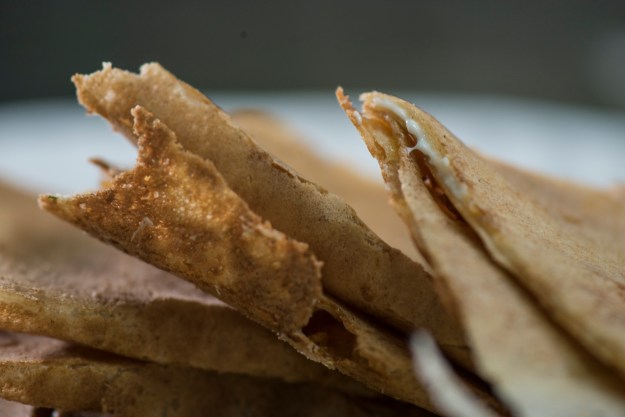
Mishkak
Casual grilled foods are staples of beachfront and mountainside Omani barbecues and picnics, family pastimes enjoyed almost every weekend when the weather is nice and cool. Even on summer nights, public beaches in Muscat are dotted with flickering campfires. The rich smell of grilling meat hangs thick in the air. There may be seafood or chicken on some grills, but most are cooking the Omani barbecue known as mishkak.
These cubes of meat (lamb, goat, or, usually, beef) are seasoned with a heady mixture of cardamom, black pepper, salt, clove, and cinnamon and layered with a piece of fat, then skewered on a stick and grilled. The skewers can be eaten as is or dunked in a spicy, sour tamarind sauce. The exotic blend of spices on this humble street-food dish reflects the country’s longtime access to goods from around the world: tamarind from South Asia, cinnamon from Indonesia, and cloves from east Africa. They are all now basic pantry staples in Oman.
Where to eat it
There are very few street foods in Oman. While you can find small stands selling fried East African and South Asian snacks like samosa, pakora, and kachori in stalls inside the Old Muttrah souk, true street food, sold by the stick on the roadside from smoking grills, is limited to mishkak. When the sticks come off the grill, nicely charred and dripping with fat, they are dunked in a spicy, tangy tamarind sauce, then wrapped in tin foil and handed to the waiting customer. The best place to find them is on the road between Al Mouj and Seeb or just in front of the Seeb Market.